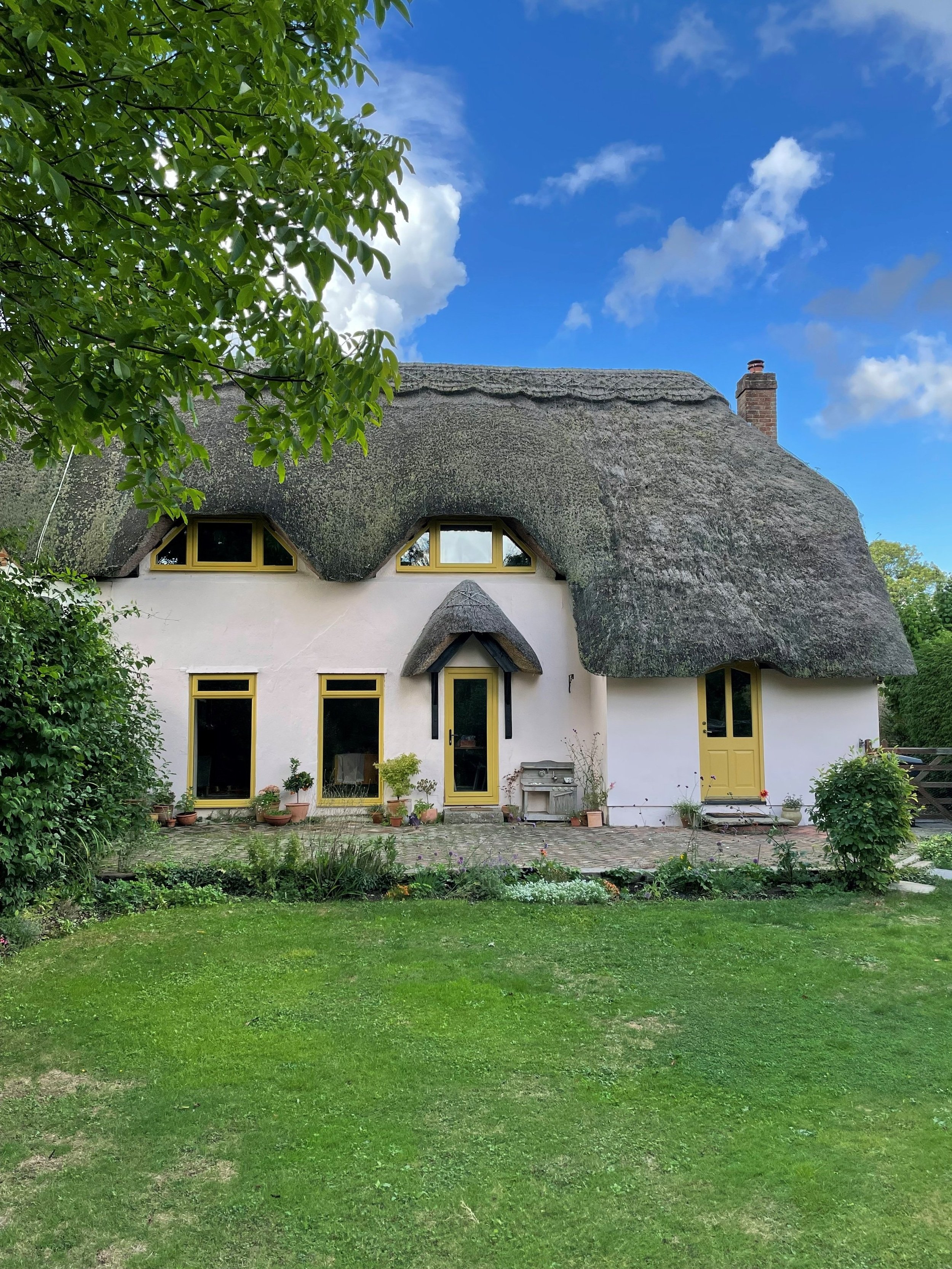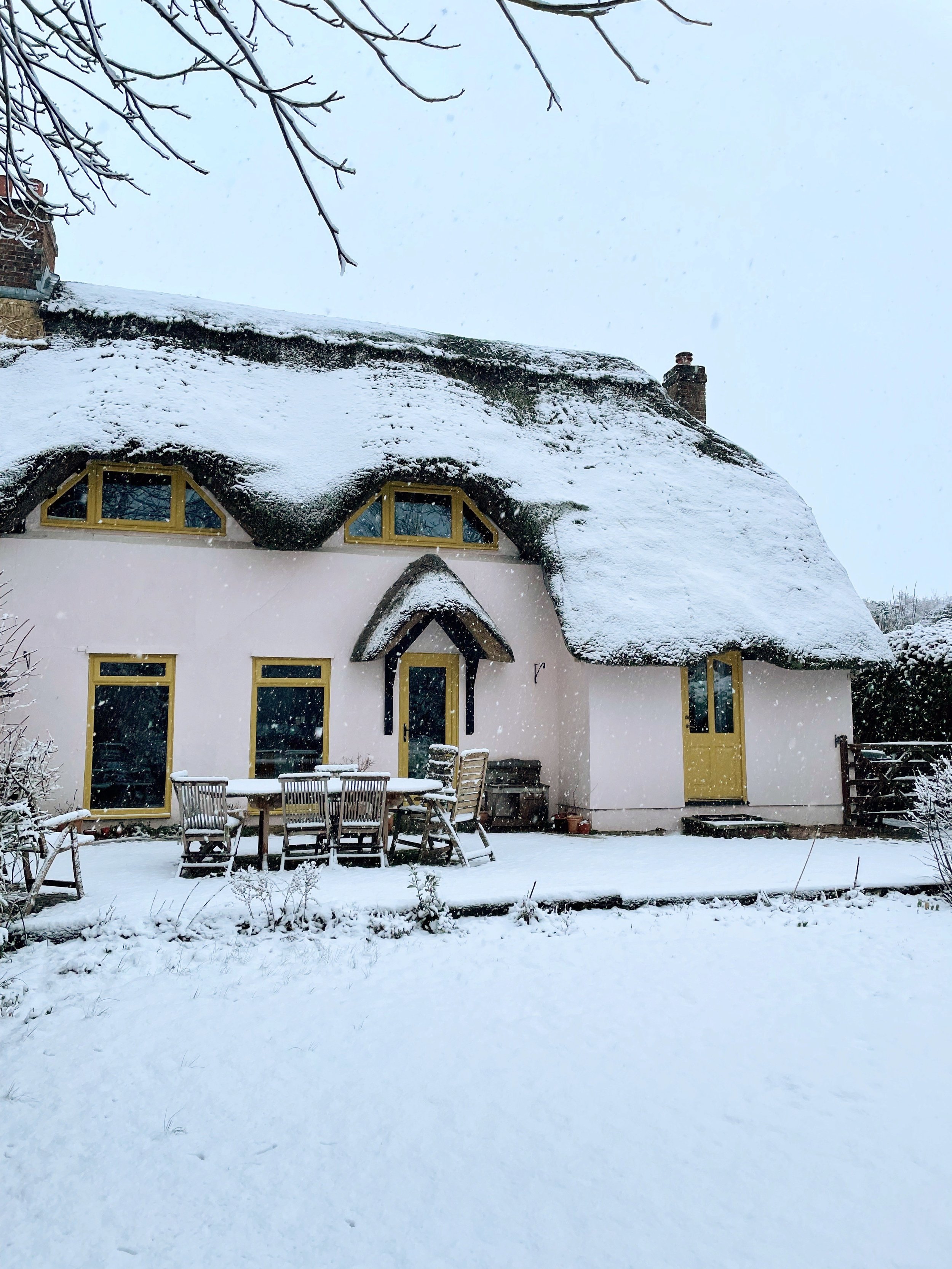Living with a thatched roof: The pros and cons
We’ve been living in our 400 year old thatched cottage for almost three years now, and, as it’s a relatively rare roof type for houses in the UK, feel like I can give a little insight into our experience so far.
In fact, there are only 60,000, thatched homes in the UK, of which 75% are listed, which means that thatched homes make up for just 0.1% (and unlisted thatched homes, likes ours, make up for 0.04%). There are many pros and cons to living and owning a home with a thatched roof, but it is undoubtedly the aesthetic that draws most people in to their charms. The unique, soft, country look, can certainly appear whimsical and romantic and the perfect backdrop for a wild cottage garden or a glisteningly white snowy day.
However, are thatched cottages as magical to live with as they appear in a photograph?
Pro’s of Living with a Thatched Roof:
Thatch keeps the house cool in the summer and warm in the winter. From a 200 year old detached cottage, an 80’s semi-detached, Edwardian mid-terrace, and 30’s semi-detached, this house is by far the most comfortable we have ever lived in. Throughout the summer the bedrooms have only reached highs of 24C (as opposed to our beautiful 30’s house which would go up to 34C in a heatwave,) and on the whole remains wonderfully cool throughout the hot weather. In the winter, we find upstairs in particular retains heat well, and it’s only our lack of decent sized radiators downstairs which is letting us down on the ground floor.
The deep overhang of the thatch protects the walls and keeps our house lovely and dry. Whether this is the same for every thatched home, I’m not sure, but this has certainly been a huge pro for me, having lived in many a damp house over the years, despite this house being the oldest we’ve ever lived in, it is by far the driest. I’m aware this is due to many factors, but one in particular, could be the overhang of the thatch creating a protective barrier for our walls, significantly reducing the amount of rain fall they receive. This is the first house I’ve lived in that has absolutely no damp, mould or compensation issues on the walls. (It must also be noted that we do have double and triple glazing though.)
Thatch is an environmentally friendly roofing method and the material comes from sustainable and renewable sources. Depending on the straw used, it can be very durable and last up to 50 years, however ours is long straw which unfortunately only lasts 15-25 years.
Thatch looks beautiful and really makes your home stand out. The material is flexible and can be worked around multiple structures with the potential for all sorts of decorative features along the ridge. It has historical significance and really does feel very special. It’s ‘rarity’ means many estate agents also believe it adds value to your home.
Thatched homes don’t have any gutters/drainage so that is one less thing to think about maintenance wise, however it does make collecting water in a butt for your plants a much more tricky endeavour!
Con’s of Living with a Thatched Roof:
The biggest factor that puts people off living in a thatched home is the risk of fire. There’s no doubt this must be taken into consideration seriously, as if a fire starts in a thatched home, it can spread very quickly and be catastrophic. Therefore, there are many extra safety measures your insurance company will insist you carry out. For instance, if you have a wood burner, annual checks on the chimney will be required, alongside certificates to prove you’re having it swept regularly (1-2 times a year,) and you will most likely need smoke alarms in every room, including the lofts. It’s best to go to your insurer to find out the extent of your properties needs. However, it is worth noting, that you’re statistically just as likely to have a fire in a home with a tiled roof as it is with a thatched roof, it’s just the speed in which it spreads that is more dangerous.
The cost of replacing a thatch, or even getting it repaired, is eye-wateringly expensive and bearing in mind your average tiled roof lasts 80 years, is certainly something thatched home owners need to consider a lot more than those in regular housing. To replace our roof fully (which is a job that is hurtling towards us at frightening speed) we will have to spend about 60k (Hampshire, 2023). The logistics of which are also difficult to navigate as you don’t want to replace too early (when it’s so expensive you need to get the most out of every single piece of straw that you can,) however, master thatchers are booked months and even years in advance so you also need to be proactive in booking them in.
One section of our thatched roof with a repair to help it last another year before fully replacing.
On this note, because it’s such a craft (it takes 7-8 years to become a master thatcher) there are fewer and fewer thatchers around, so availability is hard to come by meaning they can put their prices up. As it is such a specialist skill, we also feel slightly vulnerable that we are at their mercy when it comes to seeking their expertise on maintenance issues and when it needs to be rethatched. Over the years we have had many thatchers give us wildly different opinions on it, so it really is quite hard to work out which advice is relevant and which advice is just a trades person wanting the work.
It is also true that thatched roofs can be a haven for animals and I’m embarrassed to say, was probably more of a concern for us personally than anything else. There is not much worse than sharing your home with unwanted creatures, and with no plans to ever get a cat, we were expecting the worse. All thatch is protected with a wire netting which helps to prevent birds and rats nesting in your roof but it is, of course, not 100% animal proof. We have been pleasantly surprised however, and haven’t had any real problems in the three years we’ve been here apart from a little outbreak of mice over a six week period, which was, we believe, due to our neighbours (who are attached) having their roof rethatched so the netting had been removed, and the mice travelled through their roof into ours. Anyway, whilst this is something to consider for sure, it certainly hasn’t been as bad as we thought it would be.
The cost of insurance is also a big negative, as you pay a huge premium in comparison to living in a regular home. There are also only a few companies who will insure a thatch house so there aren’t many options when it comes to ‘shopping around’ for better deals.
We have yet to sell our house obviously, but I think when the times comes, we have a much smaller pool of people to sell to. However beautiful you have made it inside, there are many people who wouldn’t even consider a home with a thatched roof, so I am definitely interested to see how that experience differs to when we’ve sold other houses in the past. Time will tell on that one though as we have no current plans to move (famous last words!)
You can’t put solar panels on a thatched roof, and any other adaptations require specialist tradesmen. For instance, we discussed moving the soil waste pipe as I didn’t like where it was located in the bathroom. However with the pipe going up and out of the roof, just that one change would require £1000s of repairs worth to the thatch!
As you can tell I’m no expert but these are the things we’ve observed whilst living here so far. We have yet to employ a master thatcher for any repairs as we’re holding off the cost for as long as possible, but no doubt when we do, I’ll have a lot more to share. So far it has been a positive experience (I absolutely LOVE how comfortable cool/warm and not damp the house is) but to say the thought of paying for the replacement and repairs of the roof doesn’t hang over us like a thundercloud on a stormy day is definitely an understatement!
Book Recommendation:
On the Roof: A Thatcher’s Journey by Tom Allan
This memoir by Tom Allan is a beautiful and surprisingly easy to read book taking you behind the scenes of a thatcher’s life, as he works in the UK and travels beyond, talking to thatchers in the Hebrides, Denmark, Syria and Japan. A lovely read if you’re interested in the fascinating master craft of thatching!
Related Blog Posts:
Are you thinking of moving to a home with a thatched roof?
Let me know if you have any questions in the comments below, or find me hanging out here:



